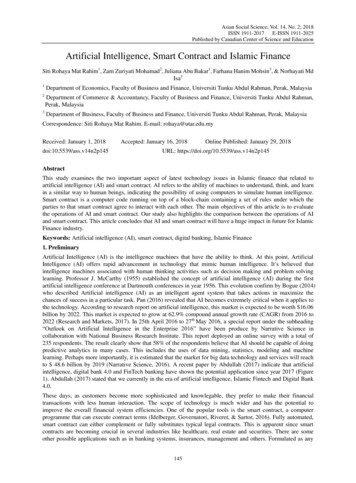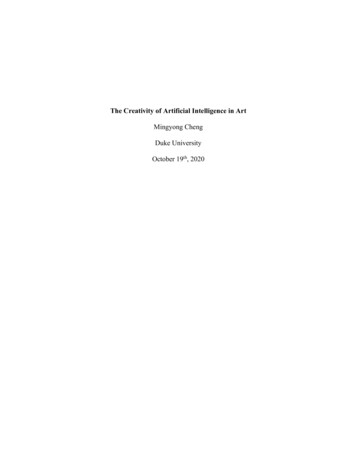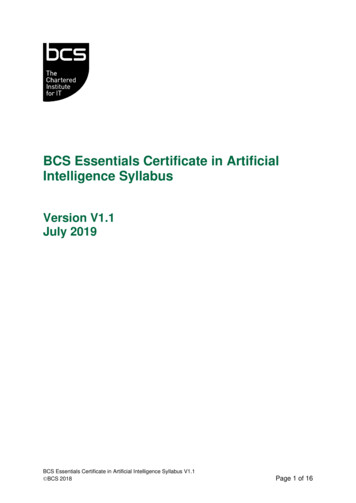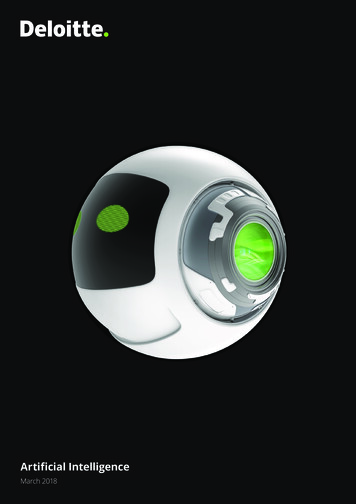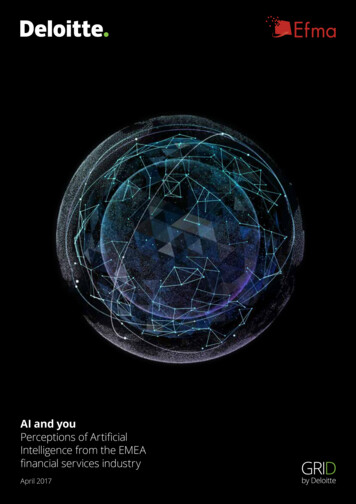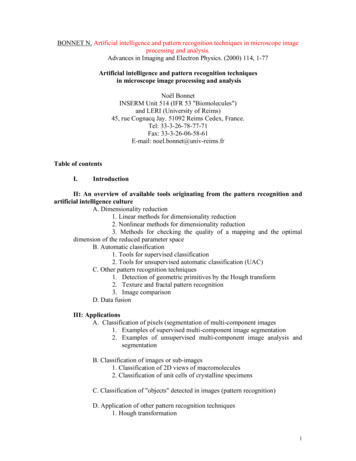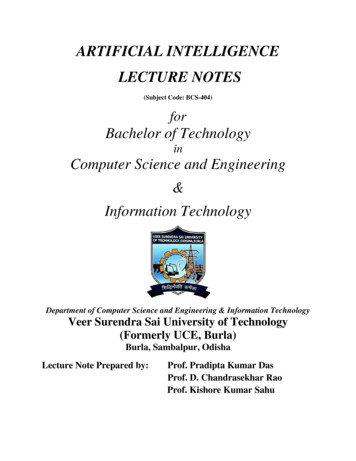
Transcription
PRESENTERSThe Rise of Artificial Intelligence (AI)and Big Data: The Consequences forBusiness, Health, and LawWyatt AndrewsJanuary 2016- to PresentProfessor of Practice, Department of Media Studies, Univ. of Virginia.Professor Andrews teaches a lecture class, The News Media: a real timelook at how the news media functions and the challenges it faces. He alsoteaches Basic and Advanced Multimedia News Reporting for studentshoping to learn professional level reporting skills.April 1991- to Sept. 2015CBS News National CorrespondentAndrews is responsible for tracking trends in politics, veterans’ affairs, health care, energy andforeign affairs. He was the principal reporter for the "CBS Evening News" segment "Eye onAmerica" from 1992-2007. During the 2008 Presidential campaign, Andrews was the primarycorrespondent for the "Reality Check" segment on the Evening News, focusing on politicalclaims and distortions.Oct 2003—Dec 2009CBS News Supreme Court CorrespondentAndrews covered key challenges to war powers, detainee rights, affirmative action andcampaign finance.Jan. 1989 to April 1991CBS News White House CorrespondentCovered the first Bush Administration. The first Gulf War. Summit meetings with the Soviets atMalta, Helsinki.Jan.1988 to Jan.1989CBS News State Department CorrespondentCovered nuclear arms control, the Afghanistan Accords, Middle East negotiations, relationswith Mikhail Gorbachev, NATO.Jan. 1986 to Jan.1988CBS News Moscow Correspondent and Bureau ChiefCovered Gorbachev’s Perestroika. Soviet society. The Chernobyl accident. Summits inReykjavik, Moscow, Washington.The biographical information is provided by the speakers or collected from their websites.
Jan. 1984 to Jan. 1986CBS News Tokyo/Asia CorrespondentCovered Japan and South Asia. Trade conflicts. The assassination of Indira Gandhi, antiMarcos unrest in the Philippines, Bhopal. Andrews joined CBS News as a reporter assigned tothe Atlanta Bureau in December 1981.(3) National Emmy awards: “The Gandhi Assassination” (1984) “The Reagan-GorbachevSummit” in Reykjavik, Iceland (1986) and “The Washington Sniper Case (2002)(1) duPont-Columbia Silver Baton award, “Sandy Hook.” (2014) Andrews was a Correspondenton the CBS News team that won this DuPont for coverage of the Newtown tragedy. The SilverBaton is considered the Pulitzer of broadcast news.Prior to CBS News: WPLG-TV Miami (December 1979-December 1981)—WFTV Orlando(February 1977-December 1979) WTVR-TV Richmond, Va., (October 1974-February 1977)2 Local Emmy Awards “Haitian Refugees,” (1981) “Crime Wave,” (1980)Spring, 2006 Adjunct Instructor: University of VirginiaTaught undergraduate course: “Journalism and the Media”Education: B.A. Government and Foreign Affairs, with honors, University of Virginia, 1974Wyatt Andrews was born in New Orleans, La., but grew up as proud Navy brat raised in Norfolk,VA. His father, Cmdr. William G. Andrews was a highly decorated Navy pilot. Andrews and hiswife Amy celebrated their 30th anniversary in 2013, and raised their four children in Vienna, VA.His hobbies include woodworking, snow skiing, water skiing and mountain biking.Raina S. Haque, J.D.Raina Haque is a Professor of Practice of Technology who focuses oncomputational law & emergent technologies. She is also the founder andlead attorney of Erdős Intellectual Property Law Startup Legal. Prior tojoining the legal profession, she was a fintech business analyst andsoftware engineer at a major Wall Street financial firm in New York City working in (ironically)clearance, trade, and settlement and global portfolio technologies. She was a research fellowat the National Institutes of Environmental Health Sciences in the Neurotoxicology and NuclearMagnetic Resonance labs working on artificial deep neural network applications. She is amongthe first patent attorneys to work in the blockchain technologies space and has written severalarticles on guidance on IP-related matters. She's called to train attorneys in the blockchainspace at major law schools and professional lecture series in New York City and Silicon Valley.She is a leading contributor to the North Carolina Bar Association's Future of the Law annualreport on blockchain technologies. In Spring 2019, she will be leading in-depth courses wherestudents and executives will not only learn about the technologies and cryptoventures, but alsoget a handle on programming in Solidity and alpha and beta test cutting-edge smart contracttechnologies.The biographical information is provided by the speakers or collected from their websites.
Other courses she is preparing speak to advances in artificial intelligence technologies andapplications, neurotechnology, online court systems, and data analytics. She practices in therealm of emerging technologies, helping to develop soft law that will guide hard law. She ispassionate about the interdisciplinary role that this coming generation of jurists can and musttake in the burgeoning realm of emergent technologies and entrepreneurialism. She offerspractical insight into developing a lean, modern, and leading practice from the ground up inLaw 469: Technology and Modern Law Practice.Bidhan (Bobby) L. ParmarAssociate Professor Bidhan ("Bobby") Parmar’s research interests focus onhow managers make decisions and collaborate in uncertain and changingenvironments to create value for stakeholders. His work helps executivesbetter handle ambiguity in their decision making. Parmar's work has beenpublished in Organization Science, Organization Studies, Journal of Applied Psychology,Business & Society, Journal of Business Ethics, Harvard Business Review, and SloanManagement Review. At Darden, he teaches First Year Ethics and a Second Year elective oncollaboration. He was recently named one of the top 40 Business School professors under 40in the world. Parmar is a fellow at the Business Roundtable Institute for Corporate Ethics, TheOlsson Center for Applied Ethics and the Safra Center for Ethics at Harvard University.Art Saavedra, MD, PhD, MBA, FAADAfter graduating Magna Cum Laude from Harvard College with a degree inBiological Sciences, Dr. Saavedra received a combined medical anddoctoral degree from the University of Pennsylvania, with specializedtraining in Pharmacology. He completed his residency training in InternalMedicine at the Brigham and Women’s Hospital, where he was also Chief Resident. Hegraduated from the Harvard Combined Dermatology Residency Training Program andcompleted a fellowship in Dermatopathology. He has served in various leadership roles atHarvard including Chair of Quality and Service and most recently, Vice Chair for Clinical Affairsand Medical Director in the Department of Dermatology at the Massachusetts GeneralHospital. He has co-authored many peer-reviewed articles and is a primary editor onFitzpatrcik’s Color Atlas and Synopsis of Dermatology, the most widely read dermatologic atlasinternationally. He completed a Business Degree at the Babson College program forEntrepreneurship and was chosen for the Finance Intensive Program before graduating SummaCum Laude. He has been a consultant to several Biotech and Pharma companies in the area ofdue-diligence, competitive landscape and product development. He is currently the Kenneth E.Greer Endowed Professor of Dermatology, a full-tenured Professor and Chairman of theDepartment.The biographical information is provided by the speakers or collected from their websites.
The Rise of ArtificialIntelligence (AI) and BigData: The Consequencesfor Business, Health, andLawJanuary 25, 2019 Williamsburg Lodge Williamsburg, VACONTINUINGLEGALEDUCATIONWritten MaterialsA presentation of The Virginia BarAssociation’s Committee on SpecialIssues of National & StateImportance
15th Annual Law and Technology CLE Sponsored by theLaw Practice Management Committee of the Fairfax Bar AssociationOCTOBER 17, 2017, 6:00P.M. – 7:00P.M., Fairfax CourthouseEthics and Marketing: Making Sure Your Online Marketing Passes Ethics Review MusterSpeakers: Chip Molster, and Seth Guggenheim of the Virginia State Bar1) 6:00pm – 6:05pm Introduction of Speakers2) 6:05pm – 6:20pm Summary of recent changes to the Virginia Rules of Professional Conduct with regard tolawyer advertisinga) Amendments approved in Feb. 25, 2017, went into effect July 1, 2017i) Changes to Rules 7.1-7.5 to achieve several basic principles:(1) the advertising rules should be focused on the appropriate regulatory purpose, protecting thepublic; (2) the rules must facially and as applied withstand constitutional scrutiny; (3) the rules mustbe legally and practically enforceable; and (4) the rules should be practical in application to evolvingmeans of communication and promotion of legal services.13) 6:20pm – 6:40pma) Proposed LEO 1885: Avvo Legal Services and Other Online Lead Generation Companies and Rules 5.4(a) and7.3(b) – this proposed LEO is not beign forwarded to VSB yet, but contains guidance that may be helpfuli) What is the relevance of whether a platform is an online referral service or something elseii) Online Lawyer-client Matching Services, or “ACMS”es(a) can they be used in Virginia without running afoul of the Rules of Professional Conduct?(i) Examples of using ACMS ethically, not ethicallyiii) Supreme Court of Ohio Board of Professional Conduct 2016-32iv) LEO 16-06 from South Carolina; LEO 2016-200 from Pennsylvania; ruling from New Jersey EthicsCommittee as of June 21, 2017 stating use of AVVO, LegalZoom, Rocket violate New Jersey ethics rulesb) ABA Formal Opinion 477 and its impact on online marketingi)A lawyer generally may transmit information relating to the representation of a client over the internetwithout violating the Model Rules of Professional Conduct where the lawyer has undertaken reasonableefforts to prevent inadvertent or unauthorized access. However, a lawyer may be required to take specialsecurity precautions to protect against the inadvertent or unauthorized disclosure of client informationwhen required by an agreement with the client or by law, or when the nature of the information requiresa higher degree of security.34) 6:40pm – 6:50pm Best practices in complying with ethics rules when marketing one’s services and/or law firmonlinei) Disclaimersii) Clarity about contentiii) Direction to consumers about next steps5) 6:50pm – 7:00pm Questions1See handout “Major Shift in How Lawyer Advertising Will Be Regulated In Virginia” by Karen A. Gould, Executive Director VSB,published in the June 2017 Virginia Lawyer, page 14.2Credits to Jim McCauley’s Ethics Update 2017, used here with permission from Mr. McCauley3Full text of and comment on the ABA’s Formal Opinion 477, dated May 11, 2017 will be available as part of the written materialsfor this seminar, with credits to the ABA.
Running with the Machines: Artificial Intelligence in the Practice of Lawby Sharon D. Nelson Esq. and John W. Simek 2017 Sensei Enterprises, Inc.Setting the StageBack in 2015, we wrote an article entitled “How Will Watson’s Children Impactthe Future of Law Practice?” What a lot has happened in two years! The childrenof Watson and other Artificial Intelligence (AI) technologies continue to spawn atan ever-accelerating rate.Only recently has genuine real-world usage of AI in law firms begun to flourish.Amid the initial hype, about 5% of what was ballyhooed as AI, in our judgment,was not. Even today, there is an astonishing amount of hype – everyone wants tosay they’ve boarded the AI train. As we write, an article from InfoWorld was justpublished entitled, “Artificially Inflated: It’s Time to call BS on AI.” While great‘clickbait’, we think the title overstates the case. The peaks and troughs of AI arewell documented, and as we are now at a peak, the hype factor gets greater,while the reality (often very good) is lost in the noise of the hype.As large firms, which certainly need to be at the forefront of innovation, begin toinvest considerable sums in AI, the landscape is changing. Large law firms simplycannot afford – for monetary and brand reasons – to be left behind. Clients willbegin to see the efficiencies of AI and its extraordinary possibilities wherever AImay be found. AI will be a honeypot to clients seeking those efficiencies andpossibilities.A brief note: An article of this length cannot adequately address all the players inthe legal AI market and what they can do. We call out a few names simplybecause we’ve run into these companies through colleagues or our reading.Fear of ‘Robot’ LawyersThere is no shortage of lawyers who fear they will be replaced by AI. Those whosell AI have come, in the last two years, to realize that it is hard to sell a productthat people fear will compete for their jobs. Thus we have seen marketingmorphing. Ross Intelligence, once called “The Superintelligent Lawyer” on thewebsite, is now referred to as “an artificially intelligent system that gets smartereach day to advance your legal career.” Now that is a major change in tone!There’s even a video which shows how Todd, “an exceptional lawyer” is originally
afraid of ROSS taking his job and is stuck in the mundane and repetitive task oflegal research but then comes to see ROSS as freeing him to spend time focusingon his clients rather than legal research.So that is why we named this article “Running with the Machines” – we areindeed going to have to find a way to coexist with AI. This may take the form ofnew jobs made possible with AI or new ways of doing our jobs. No matter whatthe vendor marketing says, it is clear that jobs will be lost – and it is probably afool’s mission at this point to predict how many. What we can predict is that alarge amount of legal work which lends itself to automation will indeed beautomated precisely as predicted by British futurist Richard Susskind.On the plus side, AI will be beset by all sorts of problems – especially AI devicesconnected to the Internet of Things, replete with the kinds of vulnerabilities thatare already well documented. That will foster more litigation, without a doubt.Will the machines need competent trainers? Of course. Will such things constitutea silver lining to an ominous cloud? Maybe. There will still be many jobs on thechopping block.In December of 2016, we learned that five percent of Accenture's workforce is nolonger human. At Accenture, that percentage equates to 20,000 full-timeequivalent positions. Accenture describes itself as a leading global professionalservices company providing a range of strategy, consulting, digital, technology &operations services and solutions. That kind of work sounds very much like thekind of professional services offered by lawyer.Scholars Dana Remus and Frank Levy have suggested that AI will have a“moderate” effect on areas such as legal research, drafting and due diligence,which one study puts at 40% of legal work. In many areas of law, only a “light”impact is anticipated – at least in the short term. Not sure we see it that way, butfor the sake of balance, it worth citing another view.More accurate, as we see it, is the conclusion of a Deloitte insight report releasedin 2016 which said that “profound reforms” will occur in the legal sector over thenext decade, estimating that nearly 40% of jobs in the legal sector could beautomated.
Understanding AIAmid so many resources on AI, the Defense Advanced Research Projects Agency(DARPA) has a pretty good handle on what constitutes AI. There are three AIphases broadly defined as:1) Handcrafted knowledge (many systems have this). These systems can’treally learn and handle uncertainty poorly – they can only enable reasoningover narrowly defined problems. The early self-driving cars were in thiscategory, unable to distinguish a shadow from a rock in desert driving, notknowing where to drive to be safe. Most cybersecurity applications fit here– they can study computer code, compare it to known vulnerabilities andfix it, but that’s all.2) Statistical Learning (such as Kira Systems, Watson (and ROSS), LexMachina). These applications are trained on big data. They perceive thenatural world, they may have facial recognition, and they learn from datasets. Their reasoning intelligence and abstracting capacities are still limited.They are best at classifying data and predicting consequences from it.They are statically impressive but in individual cases, often unreliable. Notethat it took less than 23 hours in March of 2016 for Twitter to corrupt Tay, abot devised by Microsoft for what the company described as an experimentin “conversational understanding.” Microsoft said the more you chat withTay, the smarter it gets, learning to engage people through conversation.But Tay was bombarded with racist, misogynistic remarks – and Tay beganto respond in kind. Microsoft pulled it in less than 24 hours.3) Contextual Adaptation (we’re not there yet). These systems will constructexplanatory contextual models to explain, for instance, why they made adecision that a cat was a cat. Sounds simple enough, but the reality is verycomplex. These systems will also reason and learn in a much more humanlike way.If you find all this fascinating, as we do, watch this 16-minute video to learn more:https://www.youtube.com/watch?v -O01G3tSYpU.
Where Legal AI is TodayMichael Mills, the co-founder and Chief Strategy Officer of Neota Logic, regularlyupdates a graphic which shows the current state of AI in the legal industry. Heidentifies players in the following areas of law: E-discovery, Contract analytics,Prediction, Legal Research, Expertise Automation.There are roughly 40 companies focused in the legal sector which Michaelbelieves qualify as using AI.So . . . what can AI actually do? We talked to Mark Tamminga, the partner inLeader Innovation Initiatives at Gowling WLG and asked how his firm uses Kira AI.He referred us to Rich Kathuria who is the firm’s National Director, ProjectManagement and Legal Logistics. Here’s what Rick had to say:“AI shows real potential – in the right circumstances and even in the not-so rightcircumstances. We used Kira recently for a very large contract analysis project forone of our clients. The project involved reviewing various agreements anddocumentation to assess the risk associated with various assets. Since Kira did nothave built-in models for these types of documents, Kira was not immediately ableto extract the required information automatically. But we were able to use thelearning capabilities of Kira to teach it to identify the key clauses within thedocumentation that we were looking for.Kira learned these well and after the training, it was able to pull out the relevantclauses in various documents. In addition, Kira’s ability to convert the scanneddocuments into readable text and run comparisons against other similaragreements made the project run much more efficiently.”We read that as a pretty good endorsement. And indeed, one of the majorfeatures of the new generation of AI is the fact that the machines are learning –faster and with more reliability.E-discoveryWe will look at this only briefly, because there is no doubt among the experts thattechnology assisted review (TAR) contains some AI. Machine Learning, NaturalLanguage Processing (NLP) and similar techniques like data or text-mining, bigdata analysis, concept search, topic modeling, clustering, audio search and
machine translation are all AI techniques that can be used to identify specificdocument categories and to search for relevant information in these documents.While there many companies offering TAR, certainly one of the leaders is Catalyst.In October of 2016, Catalyst put forth a peer-reviewed graphic showing how,using TAR 2.0, 1 reviewer could do the work of 48 reviewers using TAR 1.0,reviewing 723,537 documents in five days. You can find this infographic .Contract analyticsJPMorgan Chase is saving on law firm dollars by using software called “COIN”—short for Contract Intelligence—to review commercial loan agreements. Thesoftware reviews documents in seconds, doing work that once required 360,000hours of work each year by lawyers and loan officers. How can you read that andreally think that lawyers jobs aren’t at stake in an AI world?The bank says the software has helped reduce loan-servicing mistakes that wereoften attributable to human error in interpreting 12,000 new contracts per year.DLA Piper is using artificial intelligence software for due-diligence documentreview in mergers and acquisitions. The software searches text in contracts andthen creates a summary and an analysis.Reed Smith is testing artificial intelligence software by RAVN System, reviewinghundreds of pages of documents to identify and pull out certain items incontracts. RAVN made some mistakes, but it improved when lawyers addedinformation to their queries. The platform also picked up some mistakes missedon a first review by lawyers.We have recently seen good press about another company called LawGeex whichuses artificial intelligence to review contracts and spot missing or problematicclauses. It sure looks like a lot of transactional lawyers might have cause to benervous about losing work to the machines.PredictionLet’s take a look at one of the leading companies is up to these days. Lex Machinawas acquired by LexisNexis in 2015 and seems to be going great guns. LexisAdvance is a legal research service that now includes litigation analytics from Lex
Machina. When you next have an antitrust, copyright, patent, trademark, orsecurities case, you can use Lexis Advance to research the judge presiding overyour case. Soon (maybe even by the time this article is in print) you'll also be ableto research opposing counsel and competing law firms.Lex Machina transforms data from federal court dockets into live charts. In LexisAdvance, you can access this data by clicking on the hyperlinked judge's name inthe text of a case or in the new Legal Analytics box to the right of the case text.This link takes you to a summary with the judge's biographical information, opencases by practice area, comparisons to other judges in the district, cases filed byyear, and case timelines. These latter charts give you a sense of how long thedispute may take to resolve and the odds of a trial. Lexis Advance users can accessthese summaries without a Lex Machina subscription.For deeper insights, you can click from this summary in Lexis Advance to the LexMachina website if you have a subscription. Lex Machina's Motion Chains enablesyou to analyze your odds of success for a specific type of motion based onhistorical data. Similarly, you can see how opposing counsel has performed onsimilar cases or before your judge. You can also research parties, case damages,venues, practice areas, etc. for business development purposes. As you research,you can download briefs, exhibits, and other documents from cases of interest.We haven’t even given you the full breadth of what you can do with Lex Machinaapps, but it is increasingly impressive.Legal ResearchROSS Intelligence is the AI platform that first seemed to catch the attention of thelegal world. As we go to press, ROSS has been licensed by K&L Gates, Dentons,Lathan Watkins, BakerHostetler, Salazar Jackson, vonBriesen, Bryan Cave,Womble Carlyle, Dickinson Wright, Fennemore Craig, and likely more by the timeyou read this article.Schooled original in bankruptcy law, ROSS is now working on intellectualproperty, knowledge management systems and contract review systems. ROSScan read more than one million pages of case law in a second, which is rathermind-blowing.
Andrew Arruda, the CEO and co-founder of ROSS Intelligence, notes that AI is inits early days, rather like the Model T of cars. He also notes that all the techgiants, IBM, Google, Amazon, etc. are going “all in” on AI. Not much doubt aboutthat.Expertise AutomationCertainly one well-known leader in this area is Neota Logic which offers anartificial intelligence platform that enables clients to intelligently automate theirexpertise at Internet scale through an operationally useful form – as applicationsembedded in business systems or consulted interactively in a browser.As we were writing this article, Neota announced the release of Neota LogicSystem 8.0 which included a comprehensive redesign of the proprietary hybridreasoning engine that is the foundation of the platform along with a host of newfeatures. We noted that Neota’s home page quotes Gartner, the well-knownresearch company, which has predicted that by 2020, 85% of customerinteractions will be managed without a human. We imagine that will include a lotof law firm clients as well.Calling the FutureWe are taking a chance here – and prepared to eat a healthy slices of crow pie ifwe are wrong – but we are pretty sure that the practice of law will morph quicklyover the next decade thanks to AI. Not all the changes will be welcomed by thelegal profession, but we will have to learn to run with the machines. It’s that orextinction. Time to lace up those running shoes.The authors are the President and Vice President of Sensei Enterprises, Inc., a legal technology,cybersecurity and digital forensics firm based in Fairfax, VA. 703-359-0700 (phone) www.senseient.com
BLUE SKY THINKING:Adopting non-medical technologies toaddress a world of healthcare needsArt Saavedra, MD/PhD/MBAKenneth E. Greer Endowed Professor and ChairDepartment of Dermatology
Dr. Richard MurrayNobel Prize 1990Medicine and PhysiologyDr. Elias CoreyNobel Prize 1990Chemistry
Virtual “Scribes”
Why UVA?“The true measure of a man is how hetreats someone who can do him absolutelyno good.”--Samuel Johnson
Robot Lawyers? Artificial Intelligence and the Practice ofLawFairfax Bar AssociationOctober 17, 2017Presenters:Ed Walters, CEO, Fastcase and Adjunct Professor atGeorgetown University Law Center (teaching “The Law ofRobots”)Sharon Nelson, President, Sensei Enterprises, Inc.John Simek, Vice President, Sensei Enterprises, Inc.
Running with the Machines: Artificial Intelligence in the Practice of Lawby Sharon D. Nelson Esq. and John W. Simek 2017 Sensei Enterprises, Inc.Setting the StageBack in 2015, we wrote an article entitled “How Will Watson’s Children Impactthe Future of Law Practice?” What a lot has happened in two years! The childrenof Watson and other Artificial Intelligence (AI) technologies continue to spawn atan ever-accelerating rate.Only recently has genuine real-world usage of AI in law firms begun to flourish.Amid the initial hype, about 5% of what was ballyhooed as AI, in our judgment,was not. Even today, there is an astonishing amount of hype – everyone wants tosay they’ve boarded the AI train. As we write, an article from InfoWorld was justpublished entitled, “Artificially Inflated: It’s Time to call BS on AI.” While great‘clickbait’, we think the title overstates the case. The peaks and troughs of AI arewell documented, and as we are now at a peak, the hype factor gets greater,while the reality (often very good) is lost in the noise of the hype.As large firms, which certainly need to be at the forefront of innovation, begin toinvest considerable sums in AI, the landscape is changing. Large law firms simplycannot afford – for monetary and brand reasons – to be left behind. Clients willbegin to see the efficiencies of AI and its extraordinary possibilities wherever AImay be found. AI will be a honeypot to clients seeking those efficiencies andpossibilities.A brief note: An article of this length cannot adequately address all the players inthe legal AI market and what they can do. We call out a few names simplybecause we’ve run into these companies through colleagues or our reading.Fear of ‘Robot’ LawyersThere is no shortage of lawyers who fear they will be replaced by AI. Those whosell AI have come, in the last two years, to realize that it is hard to sell a productthat people fear will compete for their jobs. Thus we have seen marketingmorphing. Ross Intelligence, once called “The Superintelligent Lawyer” on thewebsite, is now referred to as “an artificially intelligent system that gets smartereach day to advance your legal career.” Now that is a major change in tone!There’s even a video which shows how Todd, “an exceptional lawyer” is originally
afraid of ROSS taking his job and is stuck in the mundane and repetitive task oflegal research but then comes to see ROSS as freeing him to spend time focusingon his clients rather than legal research.So that is why we named this article “Running with the Machines” – we areindeed going to have to find a way to coexist with AI. This may take the form ofnew jobs made possible with AI or new ways of doing our jobs. No matter whatthe vendor marketing says, it is clear that jobs will be lost – and it is probably afool’s mission at this point to predict how many. What we can predict is that alarge amount of legal work which lends itself to automation will indeed beautomated precisely as predicted by British futurist Richard Susskind.On the plus side, AI will be beset by all sorts of problems – especially AI devicesconnected to the Internet of Things, replete with the kinds of vulnerabilities thatare already well documented. That will foster more litigation, without a doubt.Will the machines need competent trainers? Of course. Will such things constitutea silver lining to an ominous cloud? Maybe. There will still be many jobs on thechopping block.In December of 2016, we learned that five percent of Accenture's workforce is nolonger human. At Accenture, that percentage equates to 20,000 full-timeequivalent positions. Accenture describes itself as a leading global professionalservices company providing a range of strategy, consulting, digital, technology &operations services and solutions. That kind of work sounds very much like thekind of professional services offered by lawyer.Scholars Da
foreign affairs. He was the principal reporter for the "CBS Evening News" segment "Eye on America" from 1992-2007. During the 2008 Presidential campaign, Andrews was the primary correspondent for the "Reality Check" segment on the Evening News, focusing on political claims and distortions. Oct 2003—Dec 2009 CBS News Supreme Court Correspondent


